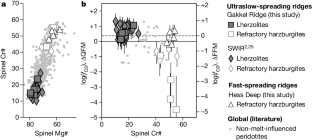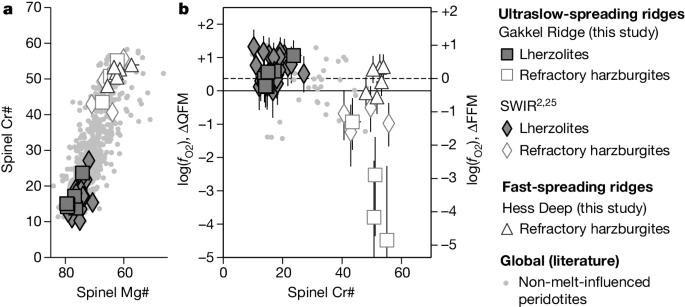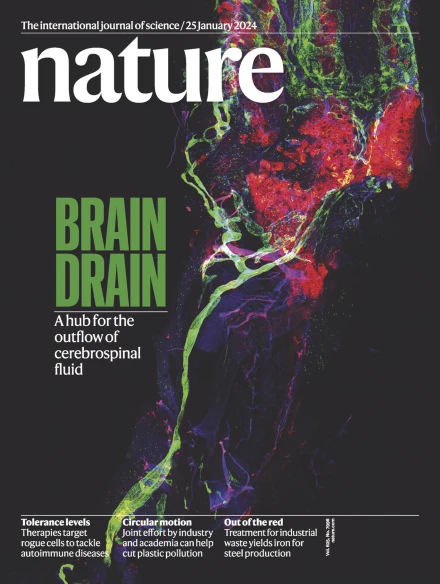Deep, hot, ancient melting recorded by ultralow oxygen fugacity in peridotites
IF 50.5
1区 综合性期刊
Q1 MULTIDISCIPLINARY SCIENCES
引用次数: 0
Abstract
The oxygen fugacity (fO2) of convecting upper mantle recorded by ridge peridotites varies by more than four orders of magnitude1–3. Although much attention has been given to mechanisms that drive variations in mantle fO2 between tectonic settings1,3,4 and to comparisons of fO2 between modern rocks and ancient-mantle-derived rocks5–10, comparatively little has been done to understand the origins of the high variability in fO2 recorded by peridotites from modern mid-ocean ridge settings. Here we report the petrography and geochemistry of peridotites from the Gakkel Ridge and East Pacific Rise (EPR), including 16 new high-precision determinations of fO2. Refractory peridotites from the Gakkel Ridge record fO2 more than four orders of magnitude below the mantle average. With thermodynamic and mineral partitioning modelling, we show that excursions to ultralow fO2 can be produced by large degrees of melting at high potential temperature (Tp), beginning in the garnet field and continuing into the spinel field—conditions met during the generation of ancient komatiites but not modern basalts. This does not mean that ambient convecting upper mantle had a lower ferric to ferrous ratio in Archaean times than today nor that modern melting in the garnet field at hotspots produce reduced magmas. Instead, it implies that rafts of ancient, refractory, ultrareduced mantle continue to circulate in the modern mantle while contributing little to modern ridge volcanism. Analysis of peridotites reveals ultralow oxygen fugacity, suggesting that rafts of ancient, ultrareduced mantle were generated by deep melting at high temperatures and continue to circulate in the modern mantle, although they contribute little to modern ridge volcanism.


橄榄岩中的超低氧富集度记录了深层、高温、古老的融化过程。
海岭橄榄岩记录的对流上地幔的氧富集度(fO2)相差超过四个数量级1-3。尽管人们对不同构造背景1,3,4 之间地幔 fO2 变化的驱动机制以及现代岩石与古地幔衍生岩石之间 fO2 的比较给予了极大关注5-10 ,但对现代大洋中脊背景橄榄岩所记录的 fO2 高变异性的起源却知之甚少。在此,我们报告了加克尔海脊和东太平洋隆起(EPR)橄榄岩的岩石学和地球化学,包括 16 项新的 fO2 高精度测定。加克尔海脊的耐火橄榄岩记录的 fO2 低于地幔平均值四个数量级以上。通过热力学和矿物分区建模,我们表明,超低 fO2 的偏移可以通过高潜在温度 (Tp) 下的大熔度熔化产生,从石榴石场开始,一直持续到尖晶石场--这些条件在古柯玛蒂岩的生成过程中就已满足,但在现代玄武岩的生成过程中却没有满足。这并不意味着环境对流的上地幔在太古宙时的铁铁比比今天低,也不意味着在热点的石榴石场的现代熔融会产生还原岩浆。相反,这意味着古老的、难熔的、超还原的地幔筏继续在现代地幔中循环,而对现代海脊火山活动的贡献却很小。
本文章由计算机程序翻译,如有差异,请以英文原文为准。
求助全文
约1分钟内获得全文
求助全文
来源期刊

Nature
综合性期刊-综合性期刊
CiteScore
90.00
自引率
1.20%
发文量
3652
审稿时长
3 months
期刊介绍:
Nature is a prestigious international journal that publishes peer-reviewed research in various scientific and technological fields. The selection of articles is based on criteria such as originality, importance, interdisciplinary relevance, timeliness, accessibility, elegance, and surprising conclusions. In addition to showcasing significant scientific advances, Nature delivers rapid, authoritative, insightful news, and interpretation of current and upcoming trends impacting science, scientists, and the broader public. The journal serves a dual purpose: firstly, to promptly share noteworthy scientific advances and foster discussions among scientists, and secondly, to ensure the swift dissemination of scientific results globally, emphasizing their significance for knowledge, culture, and daily life.
 求助内容:
求助内容: 应助结果提醒方式:
应助结果提醒方式:


